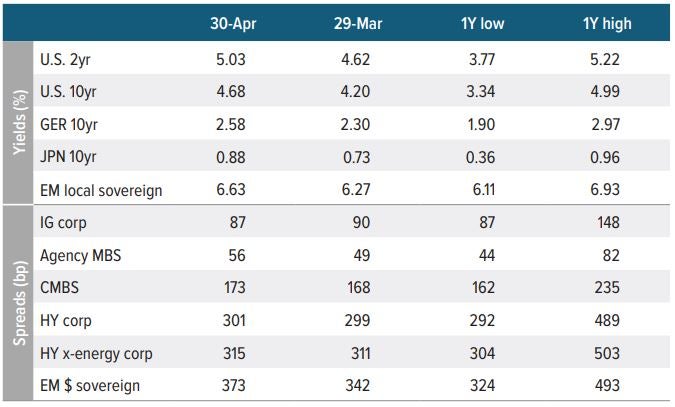
Just like we thought investors were too optimistic to start the year, we feel the outlook for monetary policy is too pessimistic now.
When it comes to “Fed watching” and interest rate cuts, we have encouraged investors to focus on the “trend” instead of the “when.” Recent inflation data has reinforced the benefits of this mindset, as April CPI data came in softer than expected (following a flurry of higher inflation prints in previous months). Just when it seemed like inflation was creeping up, the downward trend continued.
Where does that leave investors? These key points provide important context to help navigate the current market environment:
Pendulum of extremes
Since the beginning of 4Q23, market expectations have swung on a pendulum. Initially, investors became overoptimistic about the timing and number of rate cuts in 2024. With the possibility of no rate cuts now on the table (and some talking heads suggesting a rate hike is possible), the market has swung to the opposite extreme. We thought investors were too optimistic to start the year, and we feel investors are too pessimistic now
Think of inflation in bands
While it doesn’t communicate this in its monthly meetings, the Fed thinks of inflation in bands. When you get to 9% headline, you’re not in range. When inflation reaches 3% and ticks up slightly from that number, you’re in range. Said another way, even with the recent bout of higher inflation, we are still in the comfort zone, in terms of what the Fed is willing to tolerate.
All else equal, the Fed is inherently dovish
We remain in a solid growth environment, with inflation down considerably from its peak. (For those in the “stagflation” camp, see more on this below.) As long as this trend persists, the backdrop is favorable for spread assets, and the Fed will be inclined to ease monetary policy.
In Chairman Powell’s own words
In addition to this context, it’s also useful to refer to Chairman Powell’s own words from his latest press conference, where he said explicitly, “It’s unlikely that the next policy rate move will be a hike.”
Also, for anyone starting to worry about the potential for “stagflation” following the latest GDP quarterly reading of 1.6%, it’s important to remember that the labor market remains tight. To once again quote Chairman Powell, “I don’t see the stag or the ’flation.”
Our message to investors remains the same: The reset in yields to higher levels presents attractive carry opportunities. Just keep calm and clip those coupons.

As of 04/30/24. Source: Bloomberg, J.P. Morgan, Voya IM. See disclosures for more information about indexes. Past performance is no guarantee of future results.
Sector outlooks
Investment grade corporates
- Investment grade corporate fundamentals are expected to improve over the balance of the year but are unlikely to be a key driver of spreads in the near term.
- While quarterly corporate earnings have been generally positive, some consumer-related names have disappointed and reduced guidance.
- New issuance was above average in April but continued to trend down from the higher levels earlier in 2024, which provided some relief on the technical side.
- From a positioning standpoint, we remain overweight financials, BBBs and the 10-year part of the curve.
High yield corporates
- Despite less-than-compelling spread levels, the high yield market continues to print positive excess returns due to a combination of carry and a supportive technical backdrop.
- The fundamental backdrop remains supportive for credit, but there is significant tail risk in stressed business models.
- From a positioning standpoint, we are overweight food/beverage, builders/building products, health care/pharma and energy. We are underweight technology, as well as media/telecom companies with structurally challenged business models.
Senior loans
- Despite market volatility from rising geopolitical tensions and mixed economic data releases, senior loans held up well in April.
- The repricing wave slowed from March levels but continued to expand beyond stronger-rated issuers.
- There continues to be dispersion among issuers and sectors, and we maintain cautious sectoral views and up-in-quality positioning.
- We are cautious on cyclical sectors and those reliant on discretionary consumer spending. Due to sector-specific challenges, we maintain a cautious stance on the media, telecom, communications and technology sectors.
- We’re also watching an early development in the market, whereby public companies with heavy capital structures that are trading at stressed levels are more willing to engage lenders with coercive distressed exchanges—this will be a departure from recent norms, where only aggressive PE firms have exhibited such behavior.
Agency mortgages
- While April prepayment speeds are expected to increase, the general backdrop for prepayments is expected to remain muted due to a slow housing market and dampened refinancing activity.
- The performance of agency mortgages will be closely correlated with overall volatility and rate directionality in the near term.
- Longer term, fundamentals and the supply environment favor the asset class for 2024.
Securitized credit
- We view non-agency RMBS and CRT as the most actionable opportunities across securitized, as the residential mortgage credit sector remains insulated by “golden handcuffs,” tight labor markets and historically high homeowner equity.
- Non-agency RMBS: We prefer 2.0 forms of mortgage credit, which refers to loans originated and/or structured in the post-2008-crisis regulatory regime. By subsector, we have a bias toward: prime jumbo, CRT and higher-quality forms of non-QM loans. Within the legacy portion of the portfolio (< 20% and declining), we favor deals branded as being collateralized by higher-quality borrowers, as well as those that are actively receiving principle paydowns.
- CLOs: CLOs remain the securitized sector most vulnerable to a turn in the cycle. Strong structural protections should help insulate the space from a deep credit cycle, but expect more volatility in this “late-cycle” sector.
- CMBS: More pain to come as stubbornly high rates harm refinancing prospects and force lenders to reckon with defaults and lower valuations. Offices remain ground zero for stress; however, attractive opportunities to take credit risk across retail, industrial and multi-family deals are here. We expect excess returns to be driven by security selection, as opposed to a broader tightening of spreads.
- ABS: Issuers are monetizing fully scaled investor affinity via historically high new issuance. This apparent harmony between issuers and investors is driving a virtuous cycle of reliable primary market execution, leading to more issuance, which then attracts more durable capital with attractive return opportunities. We expect this sector to produce strong risk-adjusted returns.
Emerging market debt
- Emerging market (EM) debt absolute yield levels remain attractive relative to historical levels.
- While China’s latest policy response appears to have stabilized the country’s economic activity, housing and private sector confidence remain weak, and additional stimulus is unlikely.
- In our view, EM corporates are more attractive relative to the broader EM market and their U.S. peers, particularly among lower-rated issuers. We continue to find the most attractive opportunities in LatAm corporates.
A note about risk The principal risks are generally those attributable to bond investing. All investments in bonds are subject to market risks as well as issuer, credit, prepayment, extension, and other risks. The value of an investment is not guaranteed and will fluctuate. Market risk is the risk that securities may decline in value due to factors affecting the securities markets or particular industries. Bonds have fixed principal and return if held to maturity but may fluctuate in the interim. Generally, when interest rates rise, bond prices fall. Bonds with longer maturities tend to be more sensitive to changes in interest rates. Issuer risk is the risk that the value of a security may decline for reasons specific to the issuer, such as changes in its financial condition. |

